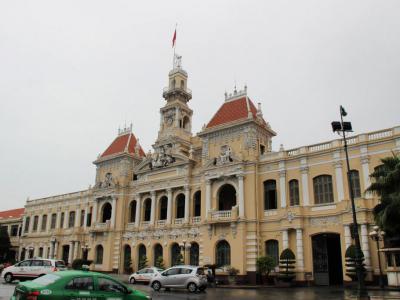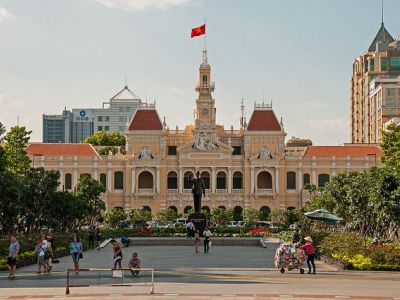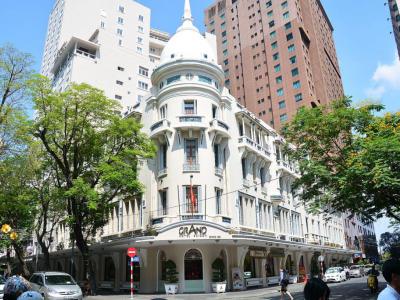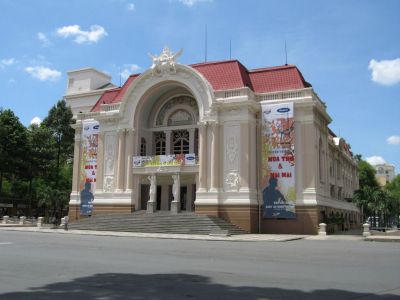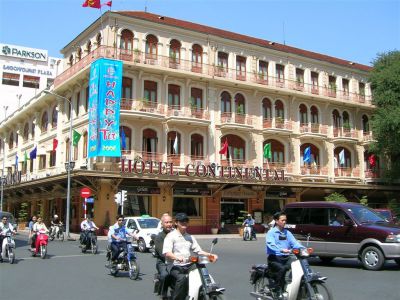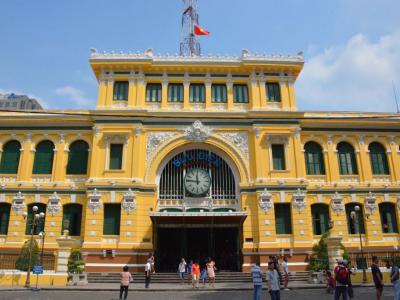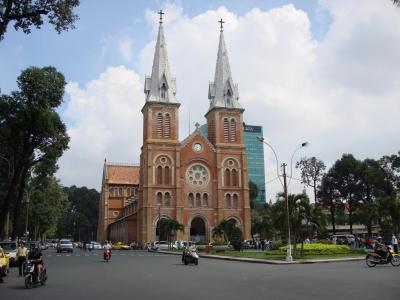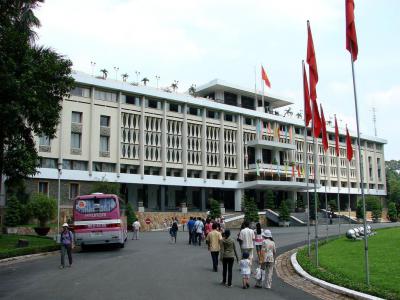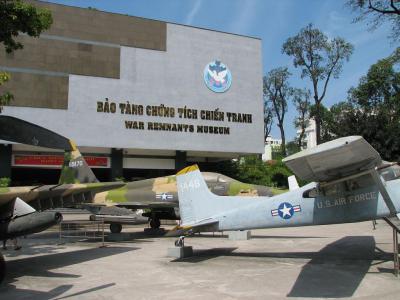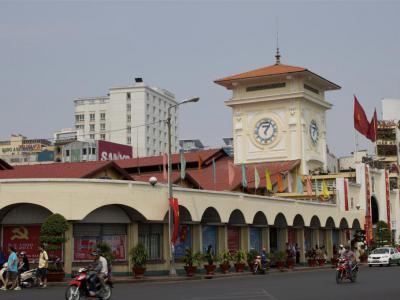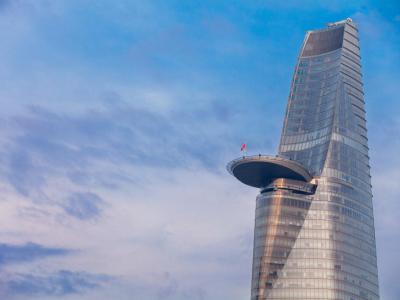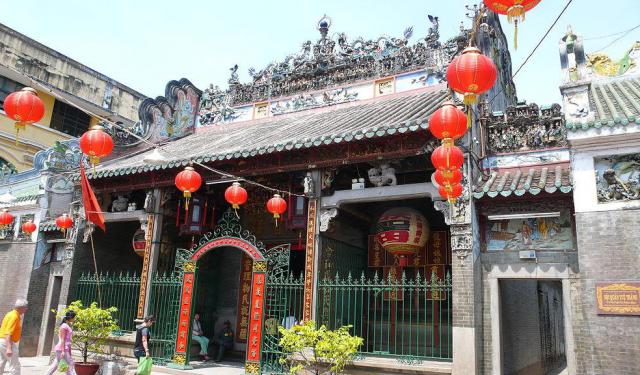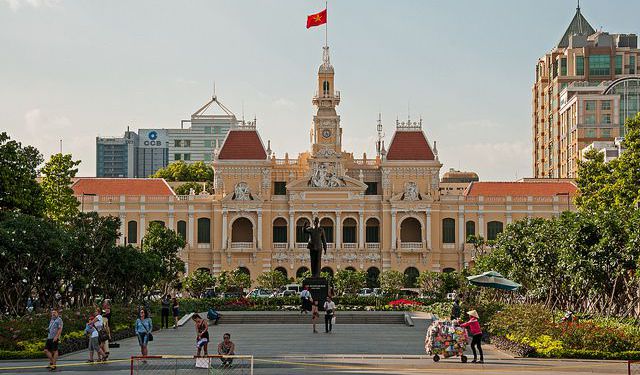
Saigon/HoChiMinh City Introduction Walking Tour (Self Guided), Saigon/HoChiMinh City
While many still refer to the city as Saigon, it was renamed Ho Chi Minh City (HCMC) in 1976 after the reunification of North and South Vietnam. The name honors the first leader of communist North Vietnam, Ho Chi Minh. But many still call the inner business district Saigon, while the larger metropolitan area is known as HCMC.
For most of its early history, this was a scarcely populated area that had been successively part of the historic kingdoms of Funan, Champa, and Khmer. The city itself came into existence in the 17th century when the Vietnamese from up north began to settle here. With the increasing influx of new arrivals, the area became more prosperous and subsequently the administrative structures were established in 1698.
The city saw another development boom after the French colonization in 1859. Many of today's Saigon's best known landmarks were built during the colonial era, including those found along Nguyen Hue Walking Street. Among them are the People's Committee Building – the old city hall, located at one end of the avenue – dating back to 1902-1908; the Saigon Opera House, constructed in 1897 to entertain French colonists; and the Hotel Continental – one of the several luxury hotels built during that period – situated just north of the street.
Other prominent local attractions include the Ben Thanh Market – popular for its shopping and food opportunities; and the unbeatable view greeting visitors to the observation deck at the Bitexco Financial Tower.
If you wish to see these and other sights firsthand and explore the city in more detail on your own, embark on this self-guided walking tour of Saigon now!
For most of its early history, this was a scarcely populated area that had been successively part of the historic kingdoms of Funan, Champa, and Khmer. The city itself came into existence in the 17th century when the Vietnamese from up north began to settle here. With the increasing influx of new arrivals, the area became more prosperous and subsequently the administrative structures were established in 1698.
The city saw another development boom after the French colonization in 1859. Many of today's Saigon's best known landmarks were built during the colonial era, including those found along Nguyen Hue Walking Street. Among them are the People's Committee Building – the old city hall, located at one end of the avenue – dating back to 1902-1908; the Saigon Opera House, constructed in 1897 to entertain French colonists; and the Hotel Continental – one of the several luxury hotels built during that period – situated just north of the street.
Other prominent local attractions include the Ben Thanh Market – popular for its shopping and food opportunities; and the unbeatable view greeting visitors to the observation deck at the Bitexco Financial Tower.
If you wish to see these and other sights firsthand and explore the city in more detail on your own, embark on this self-guided walking tour of Saigon now!
How it works: Download the app "GPSmyCity: Walks in 1K+ Cities" from Apple App Store or Google Play Store to your mobile phone or tablet. The app turns your mobile device into a personal tour guide and its built-in GPS navigation functions guide you from one tour stop to next. The app works offline, so no data plan is needed when traveling abroad.
Saigon/HoChiMinh City Introduction Walking Tour Map
Guide Name: Saigon/HoChiMinh City Introduction Walking Tour
Guide Location: Vietnam » Saigon/HoChiMinh City (See other walking tours in Saigon/HoChiMinh City)
Guide Type: Self-guided Walking Tour (Sightseeing)
# of Attractions: 12
Tour Duration: 3 Hour(s)
Travel Distance: 4.9 Km or 3 Miles
Author: vickyc
Sight(s) Featured in This Guide:
Guide Location: Vietnam » Saigon/HoChiMinh City (See other walking tours in Saigon/HoChiMinh City)
Guide Type: Self-guided Walking Tour (Sightseeing)
# of Attractions: 12
Tour Duration: 3 Hour(s)
Travel Distance: 4.9 Km or 3 Miles
Author: vickyc
Sight(s) Featured in This Guide:
- City Hall (People's Committee Building)
- Ho Chi Minh Square
- Nguyen Hue Walking Street
- Dong Khoi Street
- Saigon Opera House
- Hotel Continental
- Central Post Office
- Notre-Dame Cathedral of Saigon
- Reunification Palace
- War Remnants Museum
- Ben Thanh Market
- Bitexco Financial Tower
1) City Hall (People's Committee Building) (must see)
The Ho Chi Minh City Hall is the present name of the former Hotel de Ville or City Hall of Saigon. The ornate yellow French style building is located on the Le Thanh Ton Street at the end of the Nguyen Hue Boulevard.
The building was designed by the French architect P. Gardes and built between 1898 and 1908. It was called the Hotel de Ville until 1954. Between 1954 and 1975, it was called the City Hall of Saigon under the then South Vietnam Government. After the reunification of the country in 1975, it was given its present name, the Ho Chi Minh City People’s Committee Head Office.
Visitors to the building are greeted by a statue of Ho Chi Minh teaching a child. It is a popular spot where locals and tourists get their photographs taken. The City Hall has a renaissance style that was inspired by the design of town halls in France. It has a main hall and rectangular wings. A notable feature of the building is the bell tower that stands on a pyramid-shaped pedestal. The City Hall is spectacular when lighted up at night. It consists of working government offices and is not open to visitors.
Why You Should Visit:
Easy to walk around; plenty to see at your own pace; night time is great as well; great garden and food around the place.
The building was designed by the French architect P. Gardes and built between 1898 and 1908. It was called the Hotel de Ville until 1954. Between 1954 and 1975, it was called the City Hall of Saigon under the then South Vietnam Government. After the reunification of the country in 1975, it was given its present name, the Ho Chi Minh City People’s Committee Head Office.
Visitors to the building are greeted by a statue of Ho Chi Minh teaching a child. It is a popular spot where locals and tourists get their photographs taken. The City Hall has a renaissance style that was inspired by the design of town halls in France. It has a main hall and rectangular wings. A notable feature of the building is the bell tower that stands on a pyramid-shaped pedestal. The City Hall is spectacular when lighted up at night. It consists of working government offices and is not open to visitors.
Why You Should Visit:
Easy to walk around; plenty to see at your own pace; night time is great as well; great garden and food around the place.
2) Ho Chi Minh Square (must see)
Located right at the heart of bustling, traffic-filled Ho Chi Minh, the historic Ho Chi Minh Square is an oasis of tranquility and elegance of French Colonial architecture, perfectly manicured hedges and fragrant blooms of hibiscus and poinsettia. A snapshot of 19th- and 20th-century South Vietnamese heritage, today it is dominated by the statue of communist revolutionary leader Ho Chi Minh standing in front of the Ho Chi Minh City Hall, built by the French in 1908, and coexisting peacefully with western consumerism of today emerging in the form of high-end boutiques and big brand stores dotting the surrounding streets.
Siding the square on the east is the Rex Hotel, also built by the French, in 1927. During the Vietnam War, its rooftop bar was a popular haunt for military officials, diplomats, and war correspondents. Other nearby attractions include Saigon Opera House, Central Post Office, and several large hotels.
Tip:
Perhaps early morning, late afternoon, or evening would be a more appropriate time to visit and 'go the distance'.
Siding the square on the east is the Rex Hotel, also built by the French, in 1927. During the Vietnam War, its rooftop bar was a popular haunt for military officials, diplomats, and war correspondents. Other nearby attractions include Saigon Opera House, Central Post Office, and several large hotels.
Tip:
Perhaps early morning, late afternoon, or evening would be a more appropriate time to visit and 'go the distance'.
3) Nguyen Hue Walking Street (must see)
Running roughly northwest from the Saigon River to the Peoples Committee Building is the Nguyen Hue Walking Street. Nguyen Hue is a bustling city street with a broad, park-like median that allows for lots of pedestrian traffic. Benches and trees line the mostly paved pedestrian-only area.
Nguyen Hue is lined with restaurants, shops, bars, and nightclubs. Some of the city's iconic skyscrapers line the route, adding to its big-city charm. The area is always busy, but after dark is when it comes alive. The views from the walking street of the lit-up buildings and city lights are spectacular.
Along the walking street, you'll find several monuments, parks, and statues to explore. Near the Peoples Committee Building, you'll find a large statue of Ho Chi Minh and a water fountain that puts on hourly water and light shows.
There's always something happening along Nguyen Hue Walking Street. It's not uncommon to see festivals set up along the route, and street performers are often spotted. At night, people come to dance and party. This is the spot to head for Lunar New Year and other major holidays.
The street ends at the impressive Peoples Committee Building. The French-colonial city hall was built in the early 1900s.
Getting around Ho Chi Minh is easy thanks to a robust ferry and bus system. The ferry terminal is located right on the end of the Nguyen Hue Walking Street at the river. Many of the city's attractions are clustered around the walking street, making it something of a nexus for travels within the city. Just south of the Peoples Committee Building is the Ho Chi Minh City Museum, and just north of the lotus fountain is the City Opera House.
Nguyen Hue is lined with restaurants, shops, bars, and nightclubs. Some of the city's iconic skyscrapers line the route, adding to its big-city charm. The area is always busy, but after dark is when it comes alive. The views from the walking street of the lit-up buildings and city lights are spectacular.
Along the walking street, you'll find several monuments, parks, and statues to explore. Near the Peoples Committee Building, you'll find a large statue of Ho Chi Minh and a water fountain that puts on hourly water and light shows.
There's always something happening along Nguyen Hue Walking Street. It's not uncommon to see festivals set up along the route, and street performers are often spotted. At night, people come to dance and party. This is the spot to head for Lunar New Year and other major holidays.
The street ends at the impressive Peoples Committee Building. The French-colonial city hall was built in the early 1900s.
Getting around Ho Chi Minh is easy thanks to a robust ferry and bus system. The ferry terminal is located right on the end of the Nguyen Hue Walking Street at the river. Many of the city's attractions are clustered around the walking street, making it something of a nexus for travels within the city. Just south of the Peoples Committee Building is the Ho Chi Minh City Museum, and just north of the lotus fountain is the City Opera House.
4) Dong Khoi Street (must see)
Dong Khoi Street is one of the busiest roads in Ho Chi Minh City. It was immortalized in the novel 'The Quiet American' by the British author, Graham Greene, which later became a popular Hollywood movie.
The Dong Khoi Street extends between the Nguen Du Street and Ton Duc Thang Street. It was called the Rue Catinat under the French Rule and is flanked by many elegant French colonial style buildings. The name was changed to Freedom Street or Tu Do Street during the short-lived rule of the South Vietnam government. After the reunification of Vietnam in 1975, the street got its present name Dong Khoi, which means Total Revolution Street.
The most important landmark buildings of Ho Chi Minh City are found in Dong Khoi Street. Famous restaurants, like the Nam Kha Restaurant, and the biggest hotels, like the colonial Caravelle Hotel, the Continental Hotel, and the Majestic Hotel are located here. High-end shopping plazas and small local shops coexist side by side along the street and one can purchase some of the finest silk and silk garments and embroidered textiles from one of the many quaint local stores. Among the other landmark buildings in the street are the Saigon Notre Dame Basilica, the Saigon Opera House, and the Central Post Office.
Why You Should Visit:
Very clean – a great street to walk down and stretch your legs.
You'll find a lot going on here and there are several places to enjoy a local meal.
Tip:
It would be a good idea to bring an umbrella with you as the weather in the city is quite unpredictable at times.
Also, try a small souvenir shop called 'Vietnamese Handmade' near the Cathedral that sells some unique gifts not found elsewhere.
The Dong Khoi Street extends between the Nguen Du Street and Ton Duc Thang Street. It was called the Rue Catinat under the French Rule and is flanked by many elegant French colonial style buildings. The name was changed to Freedom Street or Tu Do Street during the short-lived rule of the South Vietnam government. After the reunification of Vietnam in 1975, the street got its present name Dong Khoi, which means Total Revolution Street.
The most important landmark buildings of Ho Chi Minh City are found in Dong Khoi Street. Famous restaurants, like the Nam Kha Restaurant, and the biggest hotels, like the colonial Caravelle Hotel, the Continental Hotel, and the Majestic Hotel are located here. High-end shopping plazas and small local shops coexist side by side along the street and one can purchase some of the finest silk and silk garments and embroidered textiles from one of the many quaint local stores. Among the other landmark buildings in the street are the Saigon Notre Dame Basilica, the Saigon Opera House, and the Central Post Office.
Why You Should Visit:
Very clean – a great street to walk down and stretch your legs.
You'll find a lot going on here and there are several places to enjoy a local meal.
Tip:
It would be a good idea to bring an umbrella with you as the weather in the city is quite unpredictable at times.
Also, try a small souvenir shop called 'Vietnamese Handmade' near the Cathedral that sells some unique gifts not found elsewhere.
5) Saigon Opera House (must see)
Saigon Opera House is one of the finest examples of 19th-century French colonial architecture in Ho Chi Minh City. It was built to stage plays and operas for the entertainment of French troops stationed in the city.
The Saigon Opera House was designed by architect Felix Olivier and its construction was supervised by architects Ernest Guichard and Eugene Ferret. It was built between 1898 and 1900. The theater was damaged by the allied bombs of World War II. After the victory of the forces of the Viet Minh in Dien Bien Phu, it became the temporary shelter for French families fleeing North Vietnam. The theater was renovated to house the lower house of parliament of South Vietnam in 1955. Its function as a performing arts venue was restored after the fall of Saigon in 1975. Extensive restorations were carried out in 1998 by the Municipal Government as part of the celebrations of the 300th anniversary of Saigon.
Visitors are greeted by two white female statues at the gate. The stairs are lined with ornate chandeliers and bronze statues. There is a main seating floor with two upper floors. The theater can seat an audience of 1800 people. Today, the Saigon Opera House is the venue for Jazz concerts, operas, traditional Vietnamese dances, and ballet performances.
Why You Should Visit:
Attending a show here is a great evening out, as you get a welcome drink as well as a tour of the beautiful Opera House before the performance. Definitely worth the price of a ticket.
Tip:
If you pre-book online they have some specials that include free dinner with the purchase of mid-priced tickets.
The Saigon Opera House was designed by architect Felix Olivier and its construction was supervised by architects Ernest Guichard and Eugene Ferret. It was built between 1898 and 1900. The theater was damaged by the allied bombs of World War II. After the victory of the forces of the Viet Minh in Dien Bien Phu, it became the temporary shelter for French families fleeing North Vietnam. The theater was renovated to house the lower house of parliament of South Vietnam in 1955. Its function as a performing arts venue was restored after the fall of Saigon in 1975. Extensive restorations were carried out in 1998 by the Municipal Government as part of the celebrations of the 300th anniversary of Saigon.
Visitors are greeted by two white female statues at the gate. The stairs are lined with ornate chandeliers and bronze statues. There is a main seating floor with two upper floors. The theater can seat an audience of 1800 people. Today, the Saigon Opera House is the venue for Jazz concerts, operas, traditional Vietnamese dances, and ballet performances.
Why You Should Visit:
Attending a show here is a great evening out, as you get a welcome drink as well as a tour of the beautiful Opera House before the performance. Definitely worth the price of a ticket.
Tip:
If you pre-book online they have some specials that include free dinner with the purchase of mid-priced tickets.
6) Hotel Continental
Very near the Saigon Opera House is the Hotel Continental, the oldest hotel in all of Vietnam. It is named for the Hotel Continental in Paris, an ode to the city's French colonial past.
The hotel was built in 1880 and has operated continuously to this day. When it was conceived, the Hotel Continental's goal was to provide traveling French businesspeople a taste of home after their long journey. During this period, many French-colonial buildings were constructed. The Notre Dame Cathedral, the Postal and Telecom Service building, and the Hotel de Ville are all built in the same style.
During the Colonial period and the First Indochina War, the hotel was a meeting place for journalists and politicians. More recently, during the Vietnam War in the 1970s, the same became true again. Time and Newsweek both kept their Saigon bureaux at the Hotel Continental. Hunter S. Thompson worked as a war correspondent here, based in room 37.
The hotel was renovated in the late 1980s and is presently owned and run by the city government.
The hotel was built in 1880 and has operated continuously to this day. When it was conceived, the Hotel Continental's goal was to provide traveling French businesspeople a taste of home after their long journey. During this period, many French-colonial buildings were constructed. The Notre Dame Cathedral, the Postal and Telecom Service building, and the Hotel de Ville are all built in the same style.
During the Colonial period and the First Indochina War, the hotel was a meeting place for journalists and politicians. More recently, during the Vietnam War in the 1970s, the same became true again. Time and Newsweek both kept their Saigon bureaux at the Hotel Continental. Hunter S. Thompson worked as a war correspondent here, based in room 37.
The hotel was renovated in the late 1980s and is presently owned and run by the city government.
7) Central Post Office (must see)
The Central Post Office is an elegant colonial-style building in the heart of Ho Chi Minh City. It has a Gothic architectural style and was designed by the world famous French architect, Gustave Eiffel. Constructed between 1886 and 1891, it resembles a European railway station. It was and is a working post office where visitors can send postcards and purchase stamps.
The Central Post Office building is the biggest post office structure in Vietnam. There are ornately wrought iron gates in the main entrance. The central hall has a large clock and two similar extensions on both sides covered by a large skylight. The arched windows have decorated capstones and green shutters that are a typical feature of French colonial buildings. The interior of the main chamber has two large maps of Vietnam and Saigon that date back to the 18th century. At the far end of the chamber hangs a giant portrait of the Vietnamese revolutionary leader, Ho Chi Minh. Besides postal mail services, the post office offers public phone and fax facilities. The specialty stamp counter sells some unusual philately sets.
Why You Should Visit:
You really feel transported back in time here, plus it's a great opportunity to send a postcard to your family back home and show them what we did before e-mail!
Tip:
Souvenir shop prices are steep, but there's a sweet spot by the entrance for air conditioning/breeze. The building is particularly beautiful when lit up at night.
The Central Post Office building is the biggest post office structure in Vietnam. There are ornately wrought iron gates in the main entrance. The central hall has a large clock and two similar extensions on both sides covered by a large skylight. The arched windows have decorated capstones and green shutters that are a typical feature of French colonial buildings. The interior of the main chamber has two large maps of Vietnam and Saigon that date back to the 18th century. At the far end of the chamber hangs a giant portrait of the Vietnamese revolutionary leader, Ho Chi Minh. Besides postal mail services, the post office offers public phone and fax facilities. The specialty stamp counter sells some unusual philately sets.
Why You Should Visit:
You really feel transported back in time here, plus it's a great opportunity to send a postcard to your family back home and show them what we did before e-mail!
Tip:
Souvenir shop prices are steep, but there's a sweet spot by the entrance for air conditioning/breeze. The building is particularly beautiful when lit up at night.
8) Notre-Dame Cathedral of Saigon (must see)
This Roman Catholic cathedral constructed by the French colonists is the seat of the Archbishop of Saigon. The red building with two pointed bell towers is a distinctive landmark of Ho Chi Minh City.
The French Bishop Isidore de Colombert laid the foundation stone of the Saigon Notre Dame Basilica in 1877. The building was designed in France and built under the supervision of a well known French engineer named Bourad. It was consecrated on Easter Day, 1880 in the presence of the then Governor of Cochin China, Charles Le Myre de Vilers. The church became a basilica in 1959 after receiving approval from the Vatican.
The Notre Dame Basilica is made from construction material imported directly from France. The bricks were made in Marseilles and the stained glass that once adorned the windows came from Chartres. It has a neo-Romanesque design with three arched façade. The two bell towers are 57.6 meters high and hold six bronze bells. Each tower is topped by a 3.5-meter high cross. In 1959, Bishop Joseph Pham Van Thien of the Saigon parish installed a statue of the Holy Mother in front of the church. In 2005, a story that the statue had shed tears circulated and thousands of visitors came to view the phenomenon. The clergy later denied the occurrence of the incident.
The French Bishop Isidore de Colombert laid the foundation stone of the Saigon Notre Dame Basilica in 1877. The building was designed in France and built under the supervision of a well known French engineer named Bourad. It was consecrated on Easter Day, 1880 in the presence of the then Governor of Cochin China, Charles Le Myre de Vilers. The church became a basilica in 1959 after receiving approval from the Vatican.
The Notre Dame Basilica is made from construction material imported directly from France. The bricks were made in Marseilles and the stained glass that once adorned the windows came from Chartres. It has a neo-Romanesque design with three arched façade. The two bell towers are 57.6 meters high and hold six bronze bells. Each tower is topped by a 3.5-meter high cross. In 1959, Bishop Joseph Pham Van Thien of the Saigon parish installed a statue of the Holy Mother in front of the church. In 2005, a story that the statue had shed tears circulated and thousands of visitors came to view the phenomenon. The clergy later denied the occurrence of the incident.
9) Reunification Palace (must see)
The Reunification Palace is a historic landmark in Ho Chi Minh City. It was here that North Vietnamese tanks breached the gates and were declared victorious in the Vietnam War resulting in the reunification of the country.
The Reunification Palace was built on the site of the former Norodom Palace. The Palace was the former residence of the French Governor of Cochin China and was also called the Governor’s Palace at the time. It was occupied by Japanese army during World War II. After the independence of Vietnam, it became the residence and office of the president of South Vietnam. The building was bombed by two rebellious pilots in 1962. The present building was designed by architect Ngo Viet Thu and opened its doors in 1966.
Visitors to the Reunification Palace are welcomed in the front lawn by the tank that breached its gates and signaled the end of the Vietnam War. The rooms of the building are preserved as they were during the war. The recreation room has many pieces of period furniture. The War command room is the most interesting part of the museum displaying early communication equipment and maps used during the war. There are also a series of underground tunnels leading to the Gia Long Palace including a basement wartime communications room. Visitors can also view a video about the Vietnam War in English at the Reunification Palace.
Tip:
When you enter, explore the ground floor first and then venture upstairs. Do the bunkers last as they exit right out of the building.
Free guided tours are available in English, French, Japanese and Chinese (invaluable as there are not many signboards inside).
The Reunification Palace was built on the site of the former Norodom Palace. The Palace was the former residence of the French Governor of Cochin China and was also called the Governor’s Palace at the time. It was occupied by Japanese army during World War II. After the independence of Vietnam, it became the residence and office of the president of South Vietnam. The building was bombed by two rebellious pilots in 1962. The present building was designed by architect Ngo Viet Thu and opened its doors in 1966.
Visitors to the Reunification Palace are welcomed in the front lawn by the tank that breached its gates and signaled the end of the Vietnam War. The rooms of the building are preserved as they were during the war. The recreation room has many pieces of period furniture. The War command room is the most interesting part of the museum displaying early communication equipment and maps used during the war. There are also a series of underground tunnels leading to the Gia Long Palace including a basement wartime communications room. Visitors can also view a video about the Vietnam War in English at the Reunification Palace.
Tip:
When you enter, explore the ground floor first and then venture upstairs. Do the bunkers last as they exit right out of the building.
Free guided tours are available in English, French, Japanese and Chinese (invaluable as there are not many signboards inside).
10) War Remnants Museum (must see)
The War Remnants Museum is currently one of the most popular museums in Vietnam, attracting approximately half a million visitors every year. According to the museum's own estimates, about two-thirds of these are foreigners.
The museum comprises a series of themed rooms in several buildings, with period military equipment placed within a walled yard. The military equipment includes a UH-1 "Huey" helicopter, an F-5A fighter, a BLU-82 "Daisy Cutter" bomb, M48 Patton tank, an A-1 Skyraider attack bomber, and an A-37 Dragonfly attack bomber. There are a number of pieces of unexploded ordnance stored in the corner of the yard, with their charges and/or fuses removed.
One building reproduces the "tiger cages" in which the South Vietnamese government kept political prisoners. Other exhibits include graphic photography, accompanied by a short text in English, Vietnamese and Japanese, covering the effects of Agent Orange and other chemical defoliant sprays, the use of napalm and phosphorus bombs, and war atrocities such as the My Lai massacre.
The photographic display includes work by Vietnam War photojournalist Bunyo Ishikawa that he donated to the museum in 1998. Curiosities include a guillotine used by the French and South Vietnamese to execute prisoners (the last time being in 1960) and three jars of preserved human fetuses allegedly deformed by exposure to dioxins and dioxin-like compounds, contained in the defoliant Agent Orange.
Why You Should Visit:
To gain extensive insight into the warfare history of the American War from the Vietnamese perspective.
Tip:
Start from the top floor and work your way down – it makes more sense. Begin with Hall 2, only then move to Hall 1. Budget a minimum of 2 hours for this activity (more if you like to spend time reading). If you're American, expect to read a lot of anti-American sentiment in the exhibition.
The museum comprises a series of themed rooms in several buildings, with period military equipment placed within a walled yard. The military equipment includes a UH-1 "Huey" helicopter, an F-5A fighter, a BLU-82 "Daisy Cutter" bomb, M48 Patton tank, an A-1 Skyraider attack bomber, and an A-37 Dragonfly attack bomber. There are a number of pieces of unexploded ordnance stored in the corner of the yard, with their charges and/or fuses removed.
One building reproduces the "tiger cages" in which the South Vietnamese government kept political prisoners. Other exhibits include graphic photography, accompanied by a short text in English, Vietnamese and Japanese, covering the effects of Agent Orange and other chemical defoliant sprays, the use of napalm and phosphorus bombs, and war atrocities such as the My Lai massacre.
The photographic display includes work by Vietnam War photojournalist Bunyo Ishikawa that he donated to the museum in 1998. Curiosities include a guillotine used by the French and South Vietnamese to execute prisoners (the last time being in 1960) and three jars of preserved human fetuses allegedly deformed by exposure to dioxins and dioxin-like compounds, contained in the defoliant Agent Orange.
Why You Should Visit:
To gain extensive insight into the warfare history of the American War from the Vietnamese perspective.
Tip:
Start from the top floor and work your way down – it makes more sense. Begin with Hall 2, only then move to Hall 1. Budget a minimum of 2 hours for this activity (more if you like to spend time reading). If you're American, expect to read a lot of anti-American sentiment in the exhibition.
11) Ben Thanh Market (must see)
The Ben Thanh Market is the most vibrant among marketplaces in Ho Chi Minh City. The shops sell a range of merchandise including clothing, leather goods, household items, and livestock.
This market is one of the oldest surviving structures in the city. It was first an informal market, created by a gathering of traders near the Saigon River. A formal market, built by the French in 1870, was burned by a fire, and the current structure was built in 1912 as the Central Market Hall. The present market's appearance is the result of a renovation in 1985.
The Ben Thanh Market consists of a neatly arranged network of aisles. The shops are grouped together according to the products they sell. The front part consists of shops selling clothing, leather, and textiles. The food section offers different types of pickled vegetables, duck, crab, rice, rice noodles, tea, coffee and spices. Local cafes and eateries are located at the end of the market where one can sample local cuisine, Vietnamese coffee and a well known Vietnamese dessert called Che. It is also a popular tourist destination because some shops sell souvenirs at lower prices than in other parts of the city.
Why You Should Visit:
Price and quality of goods here are good, plus an excellent place to enjoy local food.
Tip:
Haggling is required to get the best deal and to avoid rip-offs. The regular market is closed around 6 or 7pm, after which the night-time market will be operated outside until midnight.
This market is one of the oldest surviving structures in the city. It was first an informal market, created by a gathering of traders near the Saigon River. A formal market, built by the French in 1870, was burned by a fire, and the current structure was built in 1912 as the Central Market Hall. The present market's appearance is the result of a renovation in 1985.
The Ben Thanh Market consists of a neatly arranged network of aisles. The shops are grouped together according to the products they sell. The front part consists of shops selling clothing, leather, and textiles. The food section offers different types of pickled vegetables, duck, crab, rice, rice noodles, tea, coffee and spices. Local cafes and eateries are located at the end of the market where one can sample local cuisine, Vietnamese coffee and a well known Vietnamese dessert called Che. It is also a popular tourist destination because some shops sell souvenirs at lower prices than in other parts of the city.
Why You Should Visit:
Price and quality of goods here are good, plus an excellent place to enjoy local food.
Tip:
Haggling is required to get the best deal and to avoid rip-offs. The regular market is closed around 6 or 7pm, after which the night-time market will be operated outside until midnight.
12) Bitexco Financial Tower (must see)
Possibly the most iconic building in Ho Chi Minh City and definitely one of the tallest, the Bitexco Financial Tower is stunning. The unique glass and steel building is designed to look like Vietnam's national flower--the lotus blossom. With its stunning modern design and appearance, the building symbolizes the rapid modernization that Ho Chi Minh City has undergone in the past few decades.
On the 49th floor, you'll find the Saigon Skydeck, which opened in 2011. The 360-degree views are stunning, showing you the expanse of the city and the river below. You can get tickets for the Skydeck for any time of day, and evenings are incredibly stunning. Late nights are good, too, with the city lights sparkling from below.
The building was finished in 2010, and when it opened, it was the tallest building in Vietnam. However, it was quickly surpassed by others, and as of 2018, it stood as the fifth tallest in the country. It is also the 263rd tallest skyscraper globally at 861 feet (262 meters) and 68 floors. Bitexco, the owner of the building, is a real estate development firm headquartered in Hanoi.
Besides the Skydeck, you'll find Icon68 inside the Bitexco Tower. This is a five-level entertainment, retail, and dining space. Among many things, the area has a seven-screen cinema and many food and drink options. There is also the World of Heineken, a fun beer tour that you can add to the Skydeck experience.
On the 49th floor, you'll find the Saigon Skydeck, which opened in 2011. The 360-degree views are stunning, showing you the expanse of the city and the river below. You can get tickets for the Skydeck for any time of day, and evenings are incredibly stunning. Late nights are good, too, with the city lights sparkling from below.
The building was finished in 2010, and when it opened, it was the tallest building in Vietnam. However, it was quickly surpassed by others, and as of 2018, it stood as the fifth tallest in the country. It is also the 263rd tallest skyscraper globally at 861 feet (262 meters) and 68 floors. Bitexco, the owner of the building, is a real estate development firm headquartered in Hanoi.
Besides the Skydeck, you'll find Icon68 inside the Bitexco Tower. This is a five-level entertainment, retail, and dining space. Among many things, the area has a seven-screen cinema and many food and drink options. There is also the World of Heineken, a fun beer tour that you can add to the Skydeck experience.
Walking Tours in Saigon/HoChiMinh City, Vietnam
Create Your Own Walk in Saigon/HoChiMinh City
Creating your own self-guided walk in Saigon/HoChiMinh City is easy and fun. Choose the city attractions that you want to see and a walk route map will be created just for you. You can even set your hotel as the start point of the walk.
Chinatown Walking Tour
The relationship between Vietnam and China traces back over 2,000 years. Over this time, Vietnamese culture, customs, administrative system, and even the language have been heavily influenced by the great northern neighbor. So much so, in fact, that although Vietnam had its own spoken language, until the late 1800s its official written language was Chinese.
Chinatown in Ho Chi Minh City,... view more
Tour Duration: 1 Hour(s)
Travel Distance: 3.0 Km or 1.9 Miles
Chinatown in Ho Chi Minh City,... view more
Tour Duration: 1 Hour(s)
Travel Distance: 3.0 Km or 1.9 Miles
Historical Religious Sites
For centuries, Vietnamese people have practiced Confucianism and Buddhism brought over from neighboring China. Added to these Eastern teachings, in the 16th century, was Christianity – introduced to Vietnam by Western missionaries. The result of this variety of faiths has become a mixture of gorgeous Confucian and Buddhist temples and Catholic churches in Ho Chi Minh City. Some of these... view more
Tour Duration: 2 Hour(s)
Travel Distance: 5.9 Km or 3.7 Miles
Tour Duration: 2 Hour(s)
Travel Distance: 5.9 Km or 3.7 Miles
Shopping Tour
Among other accolades, Ho Chi Minh City is known as a great shopping destination. Attesting to its reputation are a plethora of street markets scattered throughout the city, selling all sorts of fresh local produce, including coffee beans, and other delights, not to mention street food and souvenirs – all at extremely competitive prices. There are also designated markets specialized in niche... view more
Tour Duration: 1 Hour(s)
Travel Distance: 2.5 Km or 1.6 Miles
Tour Duration: 1 Hour(s)
Travel Distance: 2.5 Km or 1.6 Miles
The Most Popular Cities
/ view all
